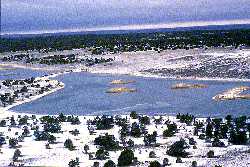Created Wetlands In Northern
Arizona
|
Treated municipal
wastewater is being used in N.E. Arizona to create some very interesting
wetlands. Wildlife response to this new habitat has been dramatic with over 120
species of birds using them. The local community is justly proud of this
example of environmental innovation and
cooperation. |
Background & History
 The City of Show Low built its first wastewater
collection and treatment system in 1958. It consisted of sewer lines, serving
the original townsite and contiguously built up areas of the city, and two
stabilization ponds for treatment. Effluent was discharged directly into Show
Low Creek, adjacent to the treatment plant, eventually reaching Fool Hollow
Lake. Nutrient loading resulted in accelerated lake eutrophication, algae
blooms, and resulting fish kills. The City of Show Low built its first wastewater
collection and treatment system in 1958. It consisted of sewer lines, serving
the original townsite and contiguously built up areas of the city, and two
stabilization ponds for treatment. Effluent was discharged directly into Show
Low Creek, adjacent to the treatment plant, eventually reaching Fool Hollow
Lake. Nutrient loading resulted in accelerated lake eutrophication, algae
blooms, and resulting fish kills.
In 1970,
with the cooperation of the U.S. Forest Service, wastewater discharge into the
creek was halted. The effluent was pumped two miles north to a natural
depression known as Telephone Lake where it contributed to the development of
wildlife habitat. In 1977, due to increasing population and resulting effluent
flows, the treatment system was expanded to include additional natural
depressions to the East which became known as Pintail and South Lake Marshes.
In Pintail Lake the U.S. Forest Service began to construct islands to enhance
waterfowl reproduction.
By 1982
wastewater flows exceeded the treatment plant's design capacity. Discharges
directly into Show Low Creek and decreased quality of effluent delivered to the
marsh treatment areas resulted in degraded habitat quality and sharply
decreased waterfowl populations. In 1985 the City began to work on a long term
solution to the problems of treatment plant capacity and providing high quality
effluent to the created wetlands.
The solution
selected was to deepen and improve the existing treatment lagoons by adding
aeration, increase pumping capacity, add stabilization ponds for secondary
treatment, increase the capacity of Telephone Lake for effluent storage, and
add additional marsh capacity for final treatment and reuse.
Treatment Facility
 The City of Show Low wastewater treatment facility now
consists of two aerated lagoons that may be operated in series or parallel, a
lift station with two 1,150 gpm pumps, four biological stabilization ponds that
may also be operated in series or parallel, a chlorination contact chamber,
effluent storage and clarification in Telephone Lake, nutrient removal in
constructed riparian areas, and eventual reuse in constructed waterfowl
marshlands. The City of Show Low wastewater treatment facility now
consists of two aerated lagoons that may be operated in series or parallel, a
lift station with two 1,150 gpm pumps, four biological stabilization ponds that
may also be operated in series or parallel, a chlorination contact chamber,
effluent storage and clarification in Telephone Lake, nutrient removal in
constructed riparian areas, and eventual reuse in constructed waterfowl
marshlands.
For more
information, please feel free to contact the USDA Forest Service, Lakeside
Ranger District at 520.368.5111 or you may write us at 2022 W. White Mtn.
Blvd., Pinetop-Lakeside, Arizona 85935
White Mountains Online wishes to express
our appreciation to the USDA Forest Service, Lakeside District for providing
this information! This and other articles may be found in print media entitled:
Constructed Wetlands for Wastewater
Treatment and Wildlife Habitat
United States Environmental Protection
Agency
#EPA832-R-93-005
September 1993
|

